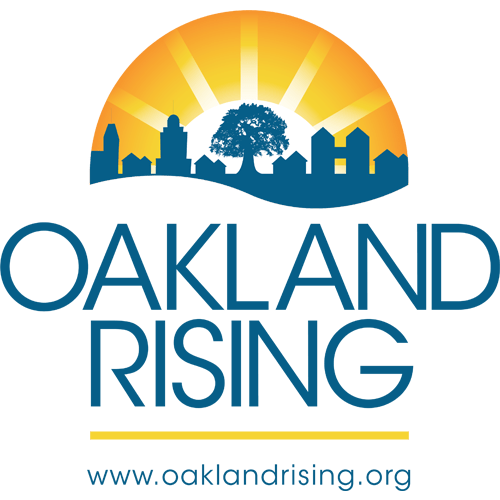By: Tracy Seipel
When she answered her front door the other day, East Oakland resident Cynthia Williams, who’s been unemployed and without medical insurance for nine years, was greeted by a bubbly 25-year-old woman wondering if she’d heard about the new health care law.
Williams said she had, but didn’t know how it would affect her. So outreach worker Dominique Gipson asked her a few more questions and quickly determined that Williams now qualifies for free health coverage.
“You’ve made my day,” the 51-year-old former nursing assistant said between a wide smile and loud hoot. “It’s an answer to my prayers.”
Oakland Rising staff member Dominique Gipson, left, gets a hug from Cynthia Williams, 51, on 103rd Avenue in East Oakland, Calif., Oct. 24, 2013. (JANE TYSKA)
Similar scenes are being played out across the Bay Area and the rest of the state as armies of paid workers and volunteers fan out in a high-stakes education and outreach effort that at times resembles an intense political campaign.
Although media attention on the implementation of the health law has focused primarily on buggy websites that debuted on Oct. 1, a large part of the effort to enroll tens of millions of uninsured people is on display on neighborhood stoops and at health fairs, town hall meetings and cultural centers.
The stakes are enormous because the success of the new health care law, officially the Affordable Care Act, depends greatly on its success in the nation’s most populous state.
Covered California, the state’s new health insurance exchange, has launched an $80 million, multilingual marketing campaign to push, pull and prod the state’s 5.8 million uninsured legal residents to sign up for insurance no later than March 31, or pay a minimum $95 fine.
The campaign includes not only television, radio, Internet and print ads to tout the new program. Covered California has also handed out $40 million to 50 nonprofit groups, unions, churches and hospitals.
“We’re excited, and it’s been really successful,” said Luisa Blue, chief elected officer of Local 521 of the Service Employees International Union, which represents 57,000 union workers from Santa Clara County to Kern County.
Of those Californians who get enrolled, some will pay the exchange’s market rates, while others will be eligible for federal subsidies. Still others, like Williams, will qualify for Medi-Cal under a provision of the health law that expanded Medicaid, a health program for the poor and disabled.
Williams, who lives with her 78-year-old mother, told Gipson — who belongs to a grass-roots group called Oakland Rising — that she’ll finally be able to see a doctor to get her bad knees fixed. And that means everything to Williams, who said that if she can walk with less pain her chances of landing a job will improve.
Oakland Rising is a member of California Calls, a coalition of 31 such groups around the state that is partially funded by the California Endowment to help publicize the health law.
So far, Covered California has not posted any enrollment figures from either its website or those generated by its ground game, something the exchange says will happen by mid-November.
That has led critics, such as the Howard Jarvis Taxpayers Association, to wonder about what kind of bang for the buck Covered California is really getting.
“Our experience has been that government is not very efficient at spending money,” said Jon Coupal, the group’s president.
Not all of the money for the outreach effort is coming from U.S. taxpayers. Foundations and other private sources are also chipping in tens of millions to make the law work here.
All those dollars staff endless rows of booths and tables with stacks of brochures. Sitting at the tables are “certified educators” who not only distribute the information, but can also answer questions about the often-confusing law. The educators then point consumers to certified enrollment counselors or certified insurance agents who can sign them up.
SEIU Local 521, which received $1 million from Covered California, has sponsored about 10 events, including a San Jose health fair in September that attracted more than 1,000 people. At some events, the union has joined forces with county health care workers to set up flu shot stations next to its own booths as a way of attracting even more attention to the new law.
Each event, she said, has drawn crowds of curious, excited people. Many of them are the working poor.
“They have never had health care before — they’ve only gone to the emergency room,” she said. “They want more information, and they want to know how they can enroll.”
SEIU has also contracted with Working Partnerships USA to operate a phone bank, targeting ZIP codes with a high percentage of uninsured. Blue said the combined strategies have helped the union contact more than 55,000 people since August.
Another organization that got a Covered California grant is the California NAACP, which received $600,000 to focus on the African-American community.
Ron Nicholson is grateful for that. Following a Sunday service at San Jose’s First AME Zion Church, the Redwood City resident stopped by the table where certified educators Ellen Rollins and Tonya York waited to answer questions and hand out materials.
“We now have a patient’s bill of rights,” York told Nicholson, “and they cannot take it away.”
A custodian who works for Redwood City, Nicholson already has medical insurance. But he picked up some brochures for a relative and friend who are uninsured.
“I believe everyone who lives in this country has a right to have medical insurance,” said Nicholson, 51. “Of course, you have to earn something in life. But some people need help.”
Sign up
Get our email updates and stay connected.
Donate
Oakland Rising is a project from our hearts for the people of Oakland. Thank you for your contribution!
